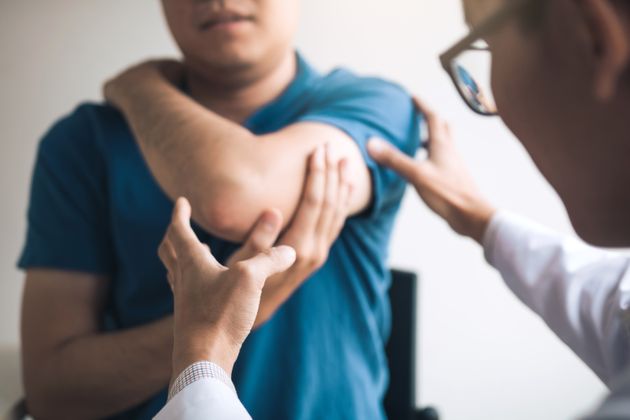
This story is from HuffPost in the US – and part of Pain in America, a nine-part series looking at some of the underlying causes of the opioid addiction crisis and how we treat pain.
Chronic pain comes in all different shapes and sizes — it burns, it aches, it stabs and throbs. Some people’s pain is linked back to muscle and joint injuries, whereas others’ pain is caused from conditions like endometriosis, cysts, nerve damage and inflammation.
And even though chronic pain — or the type of pain that lingers for months or years on end — affects about 20% of the population, we still don’t know too much about it. Many of the conditions that cause chronic pain are poorly understood, and researchers have yet to clearly identify how the brain processes different types of pain.
For many, the pain is unbearable — 8% say their pain is so intense it interferes with their ability to live. They can’t work, they can’t date, they can’t travel or work out. It can touch every part of your daily life.
Here’s what it’s actually like living with chronic pain.
Diagnosing pain is a tricky business.

Identifying the root of chronic pain isn’t easy. According to Christin Veasley, the director of the Chronic Pain Research Alliance, there’s a historic underinvestment in pain research, which means medical experts know very little about the mechanisms behind pain.
Diagnostic criteria has often been based on pain in a specific body part. “The thought is that if you have pain in your knee, there must be some sort of active disease process going on in the knee,” Veasley said.
But research has since shown that chronic pain is actually linked to irregular pain pathways all around the central nervous system (so while one might feel pain in their knee, that may not be where the pain is actually coming from). As a result, diagnosing pain is a wild game — and many conditions go either undiagnosed or misdiagnosed.
Take Jaime, a 28-year-old marketing manager in Philadelphia who experienced aches in her arm after getting ankle surgery in 2018. She was diagnosed with golfer’s elbow and put on a physical therapy plan. She was given a cortisone shot, ultrasound therapy, massages and acupuncture. Her arm pain didn’t improve and her doctors said there was nothing else they could do.
One year later, Jaime’s physical therapist suspected the pain wasn’t coming from her arm, but her neck. An X-Ray and MRI revealed three herniated discs in her neck causing damage along the nerves running through her arm.
“This entire journey has been incredibly frustrating,” said Jamie, who wished to withhold her last name to talk freely about her medical issues. “Ultimately, each step in figuring out what was wrong with me led me to where I am now, with a correct diagnosis, finally.”
You often don’t look “sick.”
When it comes to getting help, the stigma associated with chronic pain holds many people back, explained Deena Kuruvilla, a Yale Medicine neurologist who treats headache and facial pain.
“Many patients may not be coming forward due to the fear of being stigmatised,” Kuruvilla said.
Peter Whang, a Yale Medicine spine surgeon, added that there are frequently no tangible signs of chronic pain that people can see, and because of that, people with chronic pain don’t get much sympathy from friends, family, partners and co-workers.
“People may assume you’re faking it, crazy, depressed, or just drug-seeking — in many cases, it can be very difficult for these patients,” Whang said.
Plus, people with chronic pain often feel judged or criticised for how they handle their symptoms. According to the Institute for Chronic Pain, it can seem like everyone in your life has an opinion about how you should or could be coping, causing those with the pain to feel ashamed, misunderstood or defensive.
Finding a treatment isn’t a straight path.

There’s a major lack of evidence regarding which treatments work for different types of pain.
Veasley, who’s lived with chronic pain for 25 years after a car accident she was in as a teenager, said this process can be taxing as patients and clinicians often follow a “trial and error method” of testing out different treatments. It can take months to years to find the right therapy, and even then it’s not a cure — but just a way to manage symptoms so the person can function again.
Furthermore, pain changes over time and treatments may stop working or start causing a range of side effects.
People give advice, and lots of it.
Nikoly Babikian, who has endometrioma (an ovarian condition causing intense pelvic pain, especially during menstruation), said getting advice from others has been both a blessing and a curse.
On one hand, it eventually prompted her to go to the hospital and demand a diagnosis. On the other hand, the endless advice other women shared about how they handle their own period pain normalised her situation for years. Everyone seemed to have period pain, she said, so she never really thought to seek medical help for her issues.
Much of the advice given is unsolicited, with people sharing what has worked for them.
“While coming from a place of love, I don’t need those close to me telling me to ask the doctor more questions. Trust me, I’m asking all the questions,” Babikian said.
Additionally, Kuruvilla said she seen tons of patients try out advice regardless of whether it’s been scientifically studied or not.
“Many of my patients come to me after pursuing many treatment options recommended by their friends, co-workers, spouses or even acquaintances,” Kuruvilla said, noting it’s crucial to be very cautious as to which advice you heed as some of it may be quite dangerous.
Pain is inconsistent.

Pain is hard to predict — there’s usually no concrete way to know how you’re going to feel from day to day, let alone hour to hour, Veasley said. It can ebb and flow depending on various factors: your sleep, mood, activity level, stress levels and diet.
“The only thing that is consistent about my pain is that I have felt some level of pain every single day for about 16 months,” Jaime said of her battle with nerve pain.
However, it really varies from patient to patient, according to Whang. While some people will be in pain on a daily basis, others will feel it more sporadically.
Because of the unpredictable nature of pain, planning a life can be a huge challenge. Many people with persistent pain struggle to hold down a job or relationship since their pain may flare up at any time and cause them to back out of plans or responsibilities, time and time again.
Learning to live with it is incredibly challenging.
Babikian said one of the hardest things about living with endometrioma is trying not to feel like her body is failing her. At 29, she worries she shouldn’t be experiencing so much pain at such a young age. Her days revolve around her pain and doing whatever she can (from using Advil and heating pads to medical marijuana) to keep it from building.
But that’s the reality of living with chronic pain. You can’t just take a pill and be done with it. It stays, its impact ranging from minimal to complete devastation, Veasley said. For most, pain can have a tremendous psychological impact — because when you can’t do the things you want to do, it can affect every facet of your life: your work, relationships, responsibilities and your ability to function.
“I have to keep reminding myself that I still have a life to live and I need to keep living it,” Babikian said.